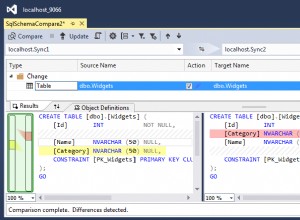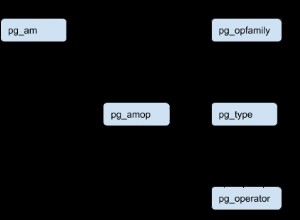Prenderesti in considerazione l'utilizzo della funzione PIPELINED per raggiungere il tuo obiettivo?
Ho scritto un esempio di tale funzione. L'esempio si basa sulla tabella, sui dati di esempio e su PIVOT query dagli articoli di Tom Kyte che puoi trovare sul suo sito:
L'articolo di Tom Kyte su PIVOT/UNPIVOT
L'articolo di Tom Kyte sulle funzioni PIPELINED
L'esempio funziona come segue.
Creiamo due tipi:
- t_pivot_test_obj - tipo che contiene le colonne che vogliamo recuperare da XML
- t_pivot_test_obj_tab - tipo di tabella nidificata degli oggetti precedenti.
Quindi creiamo una funzione PIPELINED che contiene la query con PIVOT , che genera XML (quindi non è necessario codificare i valori su cui si desidera eseguire il pivot). Questa funzione estrae i dati dall'XML generato e passa le righe (PIPE) alla query chiamante man mano che vengono generate (al volo:non vengono generate tutte in una volta, il che è importante per le prestazioni).
Infine, scrivi una query che seleziona i record da quella funzione (alla fine c'è un esempio di tale query).
CREATE TABLE pivot_test (
id NUMBER,
customer_id NUMBER,
product_code VARCHAR2(5),
quantity NUMBER
);
INSERT INTO pivot_test VALUES (1, 1, 'A', 10);
INSERT INTO pivot_test VALUES (2, 1, 'B', 20);
INSERT INTO pivot_test VALUES (3, 1, 'C', 30);
INSERT INTO pivot_test VALUES (4, 2, 'A', 40);
INSERT INTO pivot_test VALUES (5, 2, 'C', 50);
INSERT INTO pivot_test VALUES (6, 3, 'A', 60);
INSERT INTO pivot_test VALUES (7, 3, 'B', 70);
INSERT INTO pivot_test VALUES (8, 3, 'C', 80);
INSERT INTO pivot_test VALUES (9, 3, 'D', 90);
INSERT INTO pivot_test VALUES (10, 4, 'A', 100);
COMMIT;
CREATE TYPE t_pivot_test_obj AS OBJECT (
customer_id NUMBER,
product_code VARCHAR2(5),
sum_quantity NUMBER
);
/
CREATE TYPE t_pivot_test_obj_tab IS TABLE OF t_pivot_test_obj;
/
CREATE OR REPLACE FUNCTION extract_from_xml RETURN t_pivot_test_obj_tab PIPELINED
AS
v_xml XMLTYPE;
v_item_xml XMLTYPE;
v_index NUMBER;
v_sum_quantity NUMBER;
CURSOR c_customer_items IS
SELECT customer_id, product_code_xml
FROM (SELECT customer_id, product_code, quantity
FROM pivot_test)
PIVOT XML (SUM(quantity) AS sum_quantity FOR (product_code) IN (SELECT DISTINCT product_code
FROM pivot_test));
BEGIN
-- loop through all records returned by query with PIVOT
FOR v_rec IN c_customer_items
LOOP
v_xml := v_rec.product_code_xml;
v_index := 1;
-- loop through all ITEM elements for each customer
LOOP
v_item_xml := v_xml.EXTRACT('/PivotSet/item[' || v_index || ']');
EXIT WHEN v_item_xml IS NULL;
v_index := v_index + 1;
IF v_item_xml.EXTRACT('/item/column[@name="SUM_QUANTITY"]/text()') IS NOT NULL THEN
v_sum_quantity := v_item_xml.EXTRACT('/item/column[@name="SUM_QUANTITY"]/text()').getNumberVal();
ELSE
v_sum_quantity := 0;
END IF;
-- finally, for each customer and item - PIPE the row to the calling query
PIPE ROW(t_pivot_test_obj(v_rec.customer_id,
v_item_xml.EXTRACT('/item/column[@name="PRODUCT_CODE"]/text()').getStringVal(),
v_sum_quantity));
END LOOP;
END LOOP;
END;
/
SELECT customer_id, product_code, sum_quantity
FROM TABLE(extract_from_xml())
;
Uscita:
CUSTOMER_ID PRODUCT_CODE SUM_QUANTITY
---------------------- ------------ ----------------------
1 A 10
1 B 20
1 C 30
1 D 0
2 A 40
2 B 0
2 C 50
2 D 0
3 A 60
3 B 70
3 C 80
3 D 90
4 A 100
4 B 0
4 C 0
4 D 0
16 rows selected




